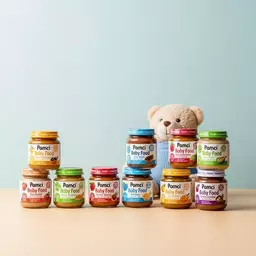Signs Your Baby is Ready for Solids (Around 6 Months)
- ✓ Good Head Control
- ✓ Shows Interest in Food
- ✓ Can Sit Up with Support
- ✓ Able to Swallow Food
As you embark on the journey of introducing solid foods to your little one, consider this: starting solids at the right time not only enhances your baby’s development but also sets the stage for healthy eating habits. Here’s what you’ll discover about supporting your baby during this exciting transition.
This visual highlights key readiness signs for introducing solids and provides a sample daily feeding schedule for 6-month-olds, integrating both milk and solid foods.
| Time | Feeding |
|---|---|
| 7:00 AM | Milk Feed |
| 8:00 AM | Solid Food (Pureed Fruit) |
| 11:00 AM | Milk Feed |
| 1:00 PM | Solid Food (Iron-Fortified Cereal) |
| 4:00 PM | Milk Feed |
| 6:00 PM | Solid Food (Pureed Vegetables) |
| 8:00 PM | Milk Feed |
As you embark on the exciting journey of introducing solid foods to your little one, it’s essential to know when the time is right. Recognizing the signs that your baby is ready for solids can make this transition smoother and more enjoyable for both of you! Let’s explore the indicators that show your baby is ready to take that leap into the world of new tastes and textures.
So, how do you know when your baby is ready to dive into solid foods? There are a few key signs to look out for, as outlined by the CDC's guidelines on infant nutrition:
Watching for these signs can help ensure a positive experience as you start this new chapter. Remember, each baby develops at their own pace, so being patient is key!
The Australian Dietary Guidelines offer valuable insights into when and how to introduce solid foods. According to these guidelines, the best time to start solids is around six months of age. This timing allows babies to develop the necessary skills for eating, while also getting the right nutrition from breast milk or formula. It’s crucial to introduce solids gradually and to ensure the foods are safe and appropriate for your baby’s age, aligning with recommendations from organizations like the American Academy of Pediatrics.
Parents should also aim to expose babies to a variety of flavors and textures as they transition to solids. This not only helps in developing their palate but also sets the foundation for healthy eating habits in the future!
As your baby approaches the six-month mark, they will hit several important feeding milestones that indicate readiness for solids:
These milestones are not just checkboxes; they represent your baby’s growing independence and curiosity about the world! Encouraging this exploration with safe, healthy options will pave the way for a positive relationship with food.
Once you've established that your baby is ready for solids, it’s time to think about what to offer! Choosing the right foods is crucial for your little one’s development.
When selecting first foods for your baby, consider options that are not only nutritious but also easy to digest. Here are some great choices, often recommended by pediatric experts such as those at Seattle Children's Hospital:
These foods not only nourish your baby but also help them develop their taste preferences as they explore different flavors!
At six months, your baby’s nutritional needs begin to change. Iron becomes a crucial nutrient as their stores from birth deplete. According to Australian health recommendations, it’s essential to introduce iron-rich foods to support their growth and development.
In addition to iron, your baby will also benefit from a balance of other nutrients like vitamins and healthy fats. A well-rounded diet will help lay the foundation for healthy eating habits as they grow!
Making homemade baby food can be a rewarding experience for you and your little one! It allows you to control the ingredients and introduce fresh, wholesome options. Here are some benefits of homemade baby food:
To get started, try simple recipes like pureed carrots or mashed avocados. Your baby will love the delightful flavors, and you’ll enjoy knowing exactly what they’re eating!
Did you know? Offering a variety of flavors and textures early on can help your baby develop a more adventurous palate. Try mixing pureed fruits with vegetables or adding a sprinkle of herbs to introduce new tastes gradually. The more diverse their early diet, the more likely they are to embrace healthy eating habits later!
As you start introducing solid foods to your little one, it’s essential to remember that breastmilk or formula will still be a vital part of their nutrition. Even at this stage, these liquids provide essential nutrients that your baby needs for growth and development. Think of it as building a strong foundation: solids will complement their diet, but milk remains the cornerstone!
During this transition, aim to maintain a good balance between milk feeds and solid foods. This way, your baby can explore new tastes while still receiving the necessary nutrition from milk. Have you noticed how excited babies get when they try something new? It's a beautiful journey to witness!
By keeping milk feeds as a significant part of their diet, you help ensure your baby gets a well-rounded approach to nutrition. I often encourage parents to think of this time as a fun exploration, where milk and solids work together to support their growing needs!
Creating a balanced feeding schedule can be a game changer! It’s all about finding the right mix of milk and solids that works for your baby. For many parents, a simple way to do this is to offer breastmilk or formula before solids. This helps your little one fill up on the important nutrients first.
What I love about this approach is its flexibility! You can always tweak the schedule based on your baby's needs and preferences. Plus, it helps to keep mealtimes from becoming overwhelming. Remember, you’re in this together, and every baby has their unique pace!
To help you visualize how to incorporate solids into your baby's diet, here’s a sample feeding schedule tailored to Australian practices. This plan keeps the focus on both milk and solids:
| Time | Feeding |
|---|---|
| 7:00 AM | Milk Feed |
| 8:00 AM | Solid Food (Pureed Fruit) |
| 11:00 AM | Milk Feed |
| 1:00 PM | Solid Food (Iron-Fortified Cereal) |
| 4:00 PM | Milk Feed |
| 6:00 PM | Solid Food (Pureed Vegetables) |
| 8:00 PM | Milk Feed |
This schedule balances milk and solid foods throughout the day, ensuring your baby’s nutritional needs are met while allowing them to explore new flavors. I find that having a structure helps parents feel more confident and organized. Plus, it sets the stage for a routine that your baby will thrive on!
Responsive feeding is all about tuning into your baby’s signals. It’s essential to observe their cues and preferences during feeding times. Are they reaching for the spoon? Are they turning their heads away? These signals can guide you in making mealtime a positive experience. Remember, it’s not only about what food they eat but also how they feel about it!
I encourage parents to embrace the messiness of this phase! It may get a little messy, but that’s part of the fun and learning. Every meal is an opportunity for discovery!
Establishing a consistent mealtime routine can help your baby develop healthy eating habits early on. By creating a familiar setting and schedule, you provide comfort and predictability. This consistency can lead to less fussiness during feedings and make them more enjoyable for you both.
As a parent, I understand that it can be tricky to juggle everything, but consistency is key! The love and attention you give during these moments will set the foundation for healthy eating habits in the future.
Here is a quick recap of the important points discussed in the article:

 What if I told you that making your own baby food could not only save you money but also give you to
What if I told you that making your own baby food could not only save you money but also give you to
 What if the choice of your baby's food could shape their entire approach to nutrition for life? As y
What if the choice of your baby's food could shape their entire approach to nutrition for life? As y
 As you navigate the often overwhelming world of baby food shopping, it's essential to arm yourself w
As you navigate the often overwhelming world of baby food shopping, it's essential to arm yourself w
 As you embark on the journey of selecting the best baby food for your little one, you might wonder h
As you embark on the journey of selecting the best baby food for your little one, you might wonder h